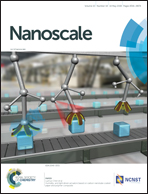Combining autophagy-inducing peptides and brefeldin A delivered by perinuclear-localized mesoporous silica nanoparticles: a manipulation strategy for ER-phagy†
Abstract
Autophagic degradation of the endoplasmic reticulum (ER-phagy) has been found to play a critical role in human sensory neuropathy. So far, however, specific and efficient intervention means for ER-phagy remain unexplored. Herein, brefeldin A (BFA), a blocking agent on protein transport between the ER and Golgi, was screened from ER stress inducers. BFA was then delivered to the perinuclear area co-localized with the ER by a mesoporous silica nanoparticle-based drug-carrier functionalized with autophagy-inducing peptides of TAT-beclin 1 (MSNs-BFA), to evoke a perturbation of ER-phagy. The molecular mechanism of ER-phagy regulated by BFA was explored by biochemical evaluation including time-lapse live-cell fluorescence imaging. We found that MSNs-BFA treatment caused a lower mRNA/protein expression level of FAM134b even under a compensation of autophagic flux in U2OS cells, and resulted in ER-expansion. The fragmentation of the ER was blocked as a response to ER stress mediated by inactivation of the AKT/TSC/mTOR pathway. Our work developed an efficient external manipulation strategy to regulate ER-phagy and may contribute to the therapeutic application of autophagy-related major human diseases.



 Please wait while we load your content...
Please wait while we load your content...